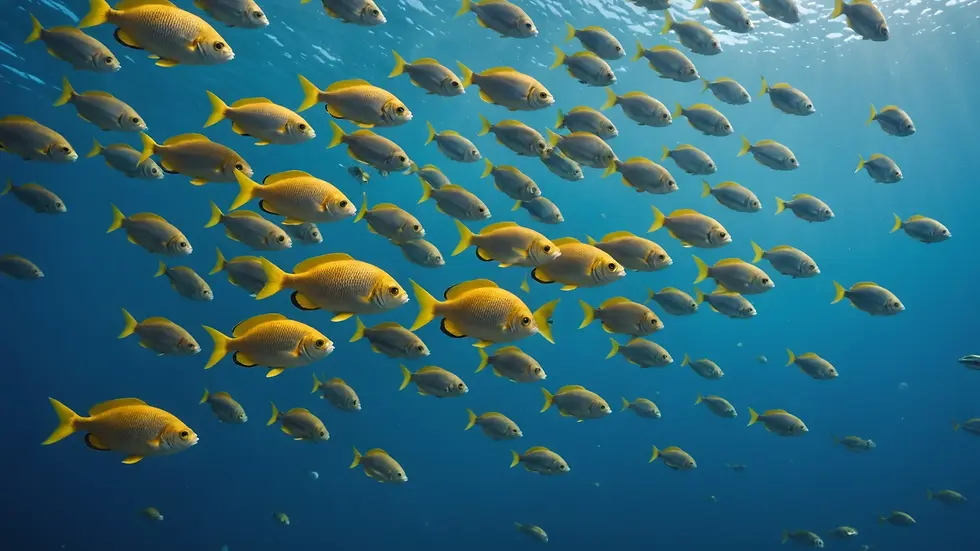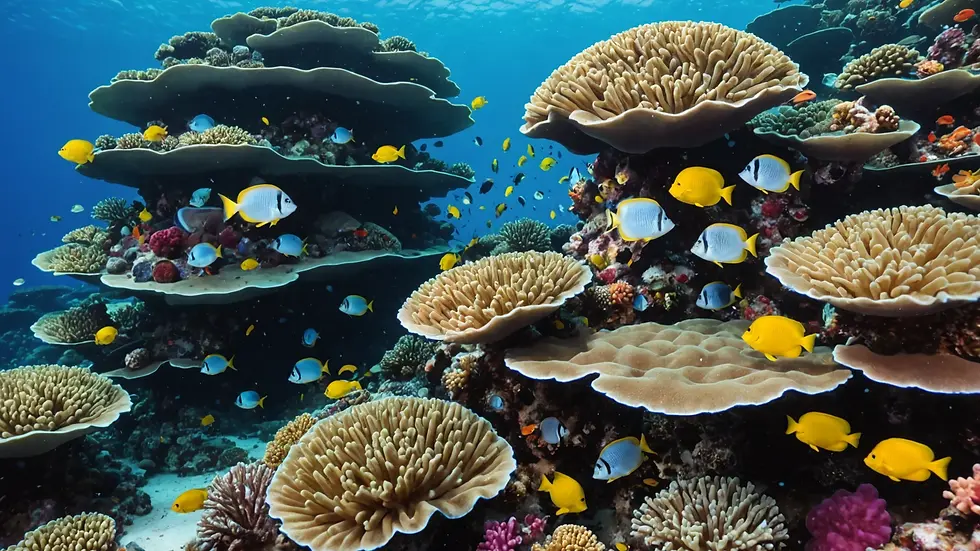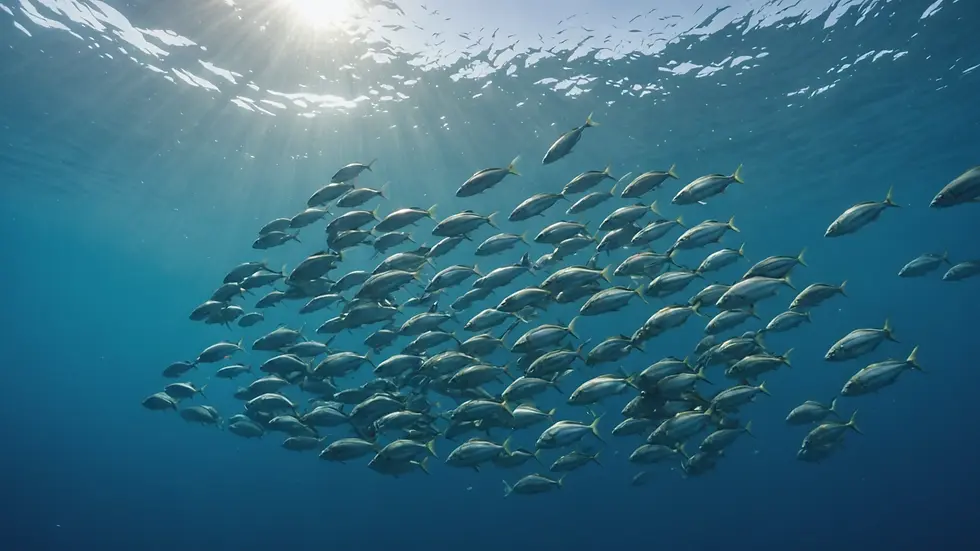The Mysterious Behavior of Fish: Why Do They School Together?
- Jyotiraj Borah
- Feb 5
- 4 min read
Fish schooling is a captivating display that has intrigued both marine biologists and everyday observers. Watching countless fish move in sync isn’t just visually stunning; it reflects a sophisticated behavior that serves vital adaptive purposes. In this article, we will explore why fish school together, examining the evolutionary benefits, the logistics of schooling, and some noteworthy species involved in this fascinating behavior.
Understanding Fish Schooling
Schooling describes the organized, coordinated movement of fish swimming closely together, often changing direction as if they are a single entity. This behavior is evident in species such as sardines, herring, and various types of tuna, each showcasing unique schooling traits. The primary reason fish school is to improve their chances of survival. By forming vast groups, individual fish can better avoid becoming prey. For example, studies show that a school of 100 fish can reduce the chances of any single fish being targeted by up to 50% compared to a lone fish.
The Benefits of Schooling
Enhanced Protection from Predators
When fish school, they confuse their predators. The rapid, synchronized movements create a mesmerizing spectacle that can disorient attackers. For instance, research indicates that schools reduced predation rates by as much as 80% when large fish chased them. This behavior is often referred to as the "many eyes" hypothesis. In a school, each fish has an improved ability to watch for threats, allowing them to react collectively and swiftly, which increases their survival chances.
Improved Foraging Efficiency
Schooling also boosts foraging success. Fish can effectively locate and capture food by spreading out during foraging, then regrouping to share their findings. For example, small schooling fish can work together to corner prey like shrimp or plankton, making it easier to feast on their findings. Schools may also enable them to target larger prey that would be impossible to catch alone.

Different Types of Schooling
Fish schooling isn't uniform. Behavior varies significantly, depending on species, environmental factors, and even time of day. Notable variations include:
Tight Schools vs Loose Aggregations
Some species, such as sardines, prefer tight formations, where fish are nearly touching and change direction sharply together. Conversely, larger predatory fish like groupers often form looser structures, allowing them room to maneuver while still benefiting from the protection a school provides.
Homogeneous vs Heterogeneous Schools
Fish may either form homogeneous schools with a single species or heterogeneous schools featuring multiple species. For instance, different species of damsel fish often school together for added safety. Such mixed schools can benefit from different predator evasion strategies unique to each species.
The Mechanics of Schooling
The spectacular coordination observed in fish schooling is attributed to specific physiological adaptations. Fish possess a lateral line system, a line of sensory organs that detect water pressure changes created by nearby movements. This system allows them to perceive their neighbors' speed and direction, facilitating synchronized swimming. Moreover, visual cues are also crucial; fish constantly monitor the positions of their companions to adjust their movements accordingly.
The Role of Social Behavior
Social dynamics significantly impact schooling behavior. Within schools, a hierarchy often dictates movement and foraging. Certain dominant fish can direct the group's actions, influencing where and how they search for food. Research has indicated that group members can also learn from successful foragers, honing their skills and enhancing survival rates.
Examples of Schooling Fish
Some fish are particularly renowned for their schooling behavior. Here are a few notable examples:
Sardines
Sardines exemplify schooling behavior, sometimes forming schools that contain millions of fish. These gatherings, often seen in areas rich in food, play a crucial role during spawning, maximizing their reproductive success and increasing species survival.
Herring
Herring are famous for their dense, tightly-knit schools, especially during the day when they tend to swim deeper, and at night, they may rise to the surface. Their dynamic movements help them evade predators while efficiently locating food sources.

Environmental Influences on Schooling
The environment significantly shapes schooling behavior. Factors like water temperature, current strength, and habitat complexity all impact when and how fish choose to school. For example, in warmer waters, fish might school closely to help regulate their body temperatures, while in colder waters, they might spread out more widely to scavenge for food.
Human Impact on Schooling
Human activities increasingly threaten the delicate ecosystems that support schooling behaviors. Overfishing, pollution, and habitat destruction disrupt fish populations. Research indicates that when fish populations dwindle, schools shrink, making individuals more vulnerable to predators. Furthermore, the loss of essential habitats, such as coral reefs, directly impacts spawning and survival rates for schooling species.
Conservation Efforts for Schooling Fish
Protecting schooling fish populations is essential for maintaining healthy marine ecosystems. Sustainable fishing practices, habitat restoration, and pollution control are crucial for ensuring the survival of these unique creatures. Organizations focused on marine conservation work to create protected areas, safeguarding crucial habitats to support schooling fish through critical life stages. Maintaining ecological balance will benefit schooling fish and enhance the overall health of marine environments.
Final Insights
The behavior of fish schooling is a remarkable adaptation that showcases the complexities of marine life. This phenomenon yields many advantages, such as greater protection from predators and improved food-finding capabilities. Grasping the reasons behind fish schooling helps us appreciate the interconnectedness of ecosystems and emphasizes the importance of marine habitat conservation.
As we learn more about the fascinating behaviors of fish, it becomes evident that our oceans hold many mysteries still to be explored. The mesmerizing movement of schooling fish reveals the intricate dynamics of group behavior, fostering endless opportunities for investigation and awe.





Comments